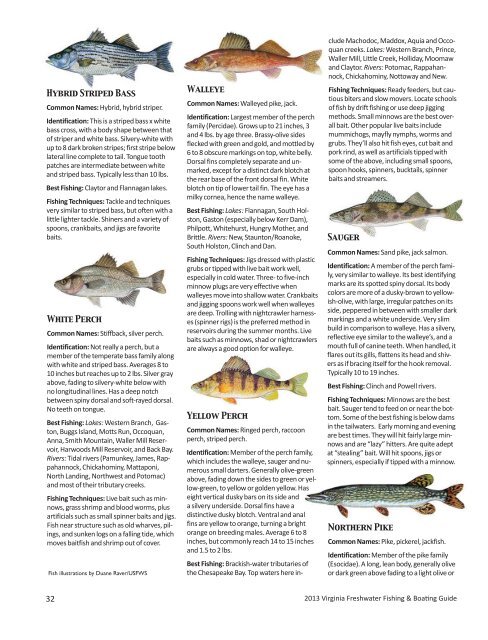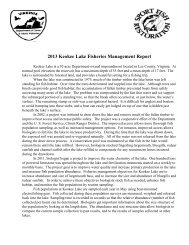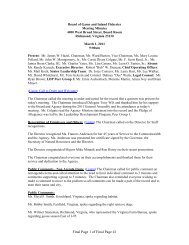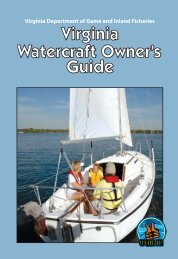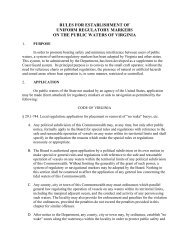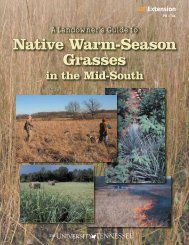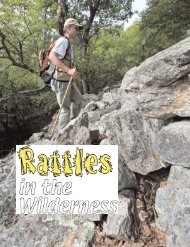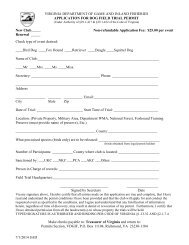2013 Virginia Freshwater Fishing & Watercraft Owner's Guide
2013 Virginia Freshwater Fishing & Watercraft Owner's Guide
2013 Virginia Freshwater Fishing & Watercraft Owner's Guide
Create successful ePaper yourself
Turn your PDF publications into a flip-book with our unique Google optimized e-Paper software.
<strong>2013</strong> <strong>Fishing</strong> Regs & WOG 11-15-12_Layout 1 11/16/12 1:01 PM Page 32Hybrid Striped BassCommon Names: Hybrid, hybrid striper.Identification: This is a striped bass x whitebass cross, with a body shape between thatof striper and white bass. Silvery-white withup to 8 dark broken stripes; first stripe belowlateral line complete to tail. Tongue toothpatches are intermediate between whiteand striped bass. Typically less than 10 lbs.Best <strong>Fishing</strong>: Claytor and Flannagan lakes.<strong>Fishing</strong> Techniques: Tackle and techniquesvery similar to striped bass, but often with alittle lighter tackle. Shiners and a variety ofspoons, crankbaits, and jigs are favoritebaits.White PerchCommon Names: Stiffback, silver perch.Identification: Not really a perch, but amember of the temperate bass family alongwith white and striped bass. Averages 8 to10 inches but reaches up to 2 lbs. Silver grayabove, fading to silvery-white below withno longitudinal lines. Has a deep notchbetween spiny dorsal and soft-rayed dorsal.No teeth on tongue.Best <strong>Fishing</strong>: Lakes: Western Branch, Gaston,Buggs Island, Motts Run, Occoquan,Anna, Smith Mountain, Waller Mill Reservoir,Harwoods Mill Reservoir, and Back Bay.Rivers: Tidal rivers (Pamunkey, James, Rappahannock,Chickahominy, Mattaponi,North Landing, Northwest and Potomac)and most of their tributary creeks.<strong>Fishing</strong> Techniques: Live bait such as minnows,grass shrimp and blood worms, plusartificials such as small spinner baits and jigs.Fish near structure such as old wharves, pilings,and sunken logs on a falling tide, whichmoves baitfish and shrimp out of cover.Fish illustrations by Duane Raver/USFWSWalleyeCommon Names: Walleyed pike, jack.Identification: Largest member of the perchfamily (Percidae). Grows up to 21 inches, 3and 4 lbs. by age three. Brassy-olive sidesflecked with green and gold, and mottled by6 to 8 obscure markings on top, white belly.Dorsal fins completely separate and unmarked,except for a distinct dark blotch atthe rear base of the front dorsal fin. Whiteblotch on tip of lower tail fin. The eye has amilky cornea, hence the name walleye.Best <strong>Fishing</strong>: Lakes: Flannagan, South Holston,Gaston (especially below Kerr Dam),Philpott, Whitehurst, Hungry Mother, andBrittle. Rivers: New, Staunton/Roanoke,South Holston, Clinch and Dan.<strong>Fishing</strong> Techniques: Jigs dressed with plasticgrubs or tipped with live bait work well,especially in cold water. Three- to five-inchminnow plugs are very effective whenwalleyes move into shallow water. Crankbaitsand jigging spoons work well when walleyesare deep. Trolling with nightcrawler harnesses(spinner rigs) is the preferred method inreservoirs during the summer months. Livebaits such as minnows, shad or nightcrawlersare always a good option for walleye.Yellow PerchCommon Names: Ringed perch, raccoonperch, striped perch.Identification: Member of the perch family,which includes the walleye, sauger and numeroussmall darters. Generally olive-greenabove, fading down the sides to green or yellow-green,to yellow or golden yellow. Haseight vertical dusky bars on its side anda silvery underside. Dorsal fins have adistinctive dusky blotch. Ventral and analfins are yellow to orange, turning a brightorange on breeding males. Average 6 to 8inches, but commonly reach 14 to 15 inchesand 1.5 to 2 lbs.Best <strong>Fishing</strong>: Brackish-water tributaries ofthe Chesapeake Bay. Top waters here in-clude Machodoc, Maddox, Aquia and Occoquancreeks. Lakes: Western Branch, Prince,Waller Mill, Little Creek, Holliday, Moomawand Claytor. Rivers: Potomac, Rappahannock,Chickahominy, Nottoway and New.<strong>Fishing</strong> Techniques: Ready feeders, but cautiousbiters and slow movers. Locate schoolsof fish by drift fishing or use deep jiggingmethods. Small minnows are the best overallbait. Other popular live baits includemummichogs, mayfly nymphs, worms andgrubs. They’ll also hit fish eyes, cut bait andpork rind, as well as artificials tipped withsome of the above, including small spoons,spoon hooks, spinners, bucktails, spinnerbaits and streamers.SaugerCommon Names: Sand pike, jack salmon.Identification: A member of the perch family,very similar to walleye. Its best identifyingmarks are its spotted spiny dorsal. Its bodycolors are more of a dusky-brown to yellowish-olive,with large, irregular patches on itsside, peppered in between with smaller darkmarkings and a white underside. Very slimbuild in comparison to walleye. Has a silvery,reflective eye similar to the walleye’s, and amouth full of canine teeth. When handled, itflares out its gills, flattens its head and shiversas if bracing itself for the hook removal.Typically 10 to 19 inches.Best <strong>Fishing</strong>: Clinch and Powell rivers.<strong>Fishing</strong> Techniques: Minnows are the bestbait. Sauger tend to feed on or near the bottom.Some of the best fishing is below damsin the tailwaters. Early morning and eveningare best times. They will hit fairly large minnowsand are “lazy” hitters. Are quite adeptat “stealing” bait. Will hit spoons, jigs orspinners, especially if tipped with a minnow.Northern PikeCommon Names: Pike, pickerel, jackfish.Identification: Member of the pike family(Esocidae). A long, lean body, generally oliveor dark green above fading to a light olive or32 <strong>2013</strong> <strong>Virginia</strong> <strong>Freshwater</strong> <strong>Fishing</strong> & Boating <strong>Guide</strong>


